If you or someone you love is living with diabetes, you’ve probably heard the name Frederick Banting.
But – beyond the scientific accolades and historical importance, who was this man, and why is he so revered in the diabetes community?
It’s not just about a medical breakthrough – it’s about saving lives in a way that seemed impossible only a century ago – and many people (including myself) are very thankful.
Early life
Frederick Grant Banting was born on 14th November 1891 in a small farming town called Alliston in Ontario, Canada.
World Diabetes Day marks his birthday and the reason November is Diabetes Awareness Month.
Growing up, Banting wasn’t a child prodigy or someone destined for greatness. He was just a regular child, but one with a deep sense of responsibility and an innate curiosity.
After studying medicine at the University of Toronto, he joined the war effort as a medical officer during World War I.
He was brave, wounded in battle, and recognised for his valour. But when he returned to Canada, he faced a challenge that was killing thousands of people: diabetes.
Watching these young lives slip away in hospitals, often wasting down to skin and bones, was gut-wrenching and Banting knew something had to be done.
Inspiration
Banting’s big idea came to him in October 1920, in the dead of night. He’d read an article about the pancreas and diabetes, and a light bulb went off. What if he could somehow extract what he called the “internal secretions” of the pancreas to help people with diabetes?
It was a radical thought – especially from a young doctor with very little research experience.
He approached John Macleod, a senior professor at the University of Toronto, managed to secure a small lab, a bit of funding, and a young student assistant named Charles Best.
With minimal resources but plenty of determination, Banting and Best set to work – and they would change the course of diabetes forever.
Leonard Thompson
Both men worked around the clock and even used stray dogs in their experiments because that was their only option.
It was messy, heartbreaking at times, and it didn’t always work. But their grit paid off.
By 1921, they’d successfully isolated insulin and tested it on diabetic dogs, dramatically lowering their blood sugar levels. It was an extraordinary moment.
The first human test came in early 1922. Leonard Thompson, a 14-year-old boy teetering on the edge of death from type 1 diabetes, was injected with Banting and Best’s insulin.
And? It worked.
Leonard’s recovery was nothing short of a miracle. His frail, withering body began to heal, and he was given a second chance at life. You can only imagine the tears of joy from his family and the ripple of hope that spread through the medical community.
Lasting impact
The news of insulin’s success travelled fast. What had once been a hopeless diagnosis now had a beacon of hope.
By 1923, insulin was being mass-produced and distributed worldwide. It was a life-saving medication that would change everything for people with diabetes.
Banting and Macleod received the Nobel Prize in 1923 for their work.
In an act of pure humility and gratitude, Banting shared his prize money with Charles Best.
It wasn’t just a scientific achievement – it was a labour of love, dedication, and the belief that no one should have to suffer and die from a disease that could be treated.
Why we celebrate Banting
Banting’s birthday, 14th November, is commemorated as World Diabetes Day.
It’s a time for the diabetes community to reflect on just how far we’ve come, thanks to one man’s grit and determination to find a cure.
For people living with diabetes today, Frederick Banting is more than just a name in a textbook.
He’s a symbol of hope and survival. It’s hard to overstate how different life would be without his groundbreaking work. Families who once watched their loved ones waste away in despair now have options, hope, and a future.
So the next time you hear Banting’s name, or World Diabetes Day mentioned, we hope you remember a man driven by compassion, grit, and with the support of a team with shared desire to make a difference.
More so than ever, his story reminds us that even in the face of overwhelming odds, a single idea and a lot of determination can change the world.




